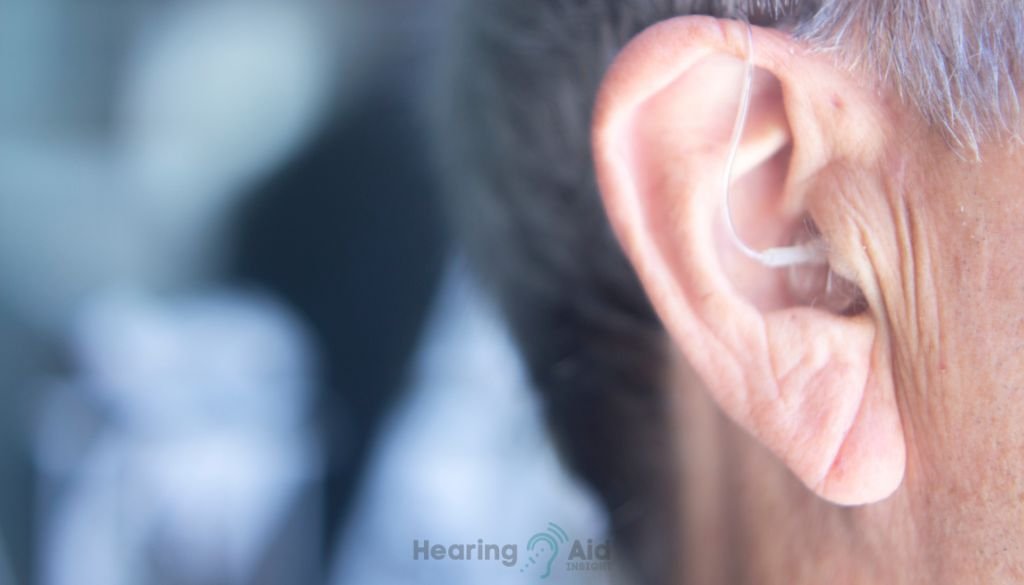Can You Push a Hearing Aid Too Far? It is vital for anyone using or considering these devices for auditory support. The delicate nature of our ears necessitates cautious handling, especially when it involves inserting devices like hearing aids. Although hearing aids are designed with safety in mind, tailored to fit the unique contours of each individual’s ear, concerns about pushing them too deeply remain valid. This article aims to clarify these concerns by exploring the intricacies of hearing aid design and their safe usage. We will delve into the engineering aspects that make it challenging to insert a hearing aid excessively far into the ear canal.

Despite this design safeguard, we also stress the importance of careful handling to prevent potential injury or discomfort. Our focus will be guiding you through the correct usage of hearing aids, emphasizing techniques to ensure both comfort and effectiveness and highlighting common mistakes to avoid to maintain ear health while benefiting from these essential auditory devices.
Key Takeaways:
- While it is technically possible to push a hearing aid too far into the ear, the design of hearing aids should prevent this from happening.
- Hearing aids are custom-moulded to fit the shape and dimensions of your ear.
- Avoid excessive force when inserting your hearing aids to prevent harm or discomfort.
- Proper usage of hearing aids is crucial for safety and comfort.
- Seek professional advice if you experience discomfort or difficulties with your hearing aid.
The Proper Way to Insert a Hearing Aid
When inserting a hearing aid, taking the time to do it properly is essential to avoid any issues and ensure a comfortable fit. Follow these steps to ensure correct insertion:
- Start with clean hands: Before handling your hearing aid, ensure your hands are clean and dry to prevent dirt or moisture from transferring to the device.
- Hold the hearing aid correctly: Gently hold it by its body or grip, avoiding contact with the microphone or receiver. This will help prevent damage to the delicate components.
- Position the hearing aid: Align it with the ear canal’s opening, ensuring it is comfortable and secure. Avoid pushing or forcing the device too far into your ear.
- Check for a snug fit: Press on the hearing aid to ensure a secure fit. It should feel comfortable and not cause any pain or discomfort.
Remember, each person’s ear and hearing aid may have slight variations, so it’s essential to familiarize yourself with the instructions provided by your audiologist or hearing care professional. These steps will help you avoid issues and ensure a proper fit for your hearing aid.
Do you need hearing aids for mild hearing loss? Learn more
“Taking the time to properly insert your hearing aid is crucial for a comfortable fit and optimal performance. By following these steps and consulting your audiologist, you can ensure that your device fits securely and enhances your overall hearing experience.” – Dr. Jessica Collins, Audiologist.
Potential Risks of Pushing a Hearing Aid Too Far
Pushing a hearing aid too far into the ear could cause damage to both the device and the ear. While it is rare for a hearing aid to become stuck due to being pushed too far, if this does happen, it is best to seek medical assistance to remove the device safely. Excessive force can also lead to scratches, irritation, and discomfort in the ear. To avoid these risks, it is essential to exercise caution and seek professional help if you are unsure about the correct insertion and fit of your hearing aid.
Damage to the Device: When a hearing aid is pushed too far into the ear, it can strain the delicate components of the device. This can lead to malfunctions or even permanent damage to the hearing aid, resulting in costly repairs or replacement.
Ear Irritation and Discomfort: Excessive force during the insertion of a hearing aid can cause irritation and discomfort in the ear. It may lead to redness, soreness, or even inflammation, making it uncomfortable to wear the device for extended periods.
Potential Ear Injuries: Pushing a hearing aid too far can also cause injuries to the ear, such as cuts or abrasions on the delicate skin inside the ear canal. These injuries may increase the risk of infections or other complications if not adequately treated.
Following the recommended guidelines for inserting a hearing aid and seeking professional assistance if unsure about the proper fit or insertion technique is crucial to prevent these risks. A qualified audiologist can help ensure that your hearing aid is positioned correctly and provide guidance on the correct use of the device, minimizing the potential for damage and discomfort.
Read Also: Can You Resell Hearing Aids?
Proper Maintenance of Hearing Aids
Ensuring proper maintenance of your hearing aids is crucial to maximize their performance and longevity. By following these tips, you can keep your device in optimal condition:
- Regular Cleaning: Clean your hearing aids daily with a soft, dry cloth to remove any wax or debris. Avoid using water or harsh chemicals, as they can damage the device. Use a wax pick or brush provided by your audiologist to clean the sound outlet and microphone.
- Battery Check: Regularly check the battery level of your hearing aids. Replace the batteries when needed to prevent sudden device failure.
- Professional Servicing: Schedule regular servicing appointments with your audiologist. They can perform thorough cleanings, check for technical issues, and make adjustments to ensure optimal performance.
- Proper Storage: When not in use, store your hearing aids in a dry and secure place. Avoid exposing them to extreme temperatures or humidity, which can damage the internal components.
In addition to these maintenance tips, you must be aware of any warning signs indicating a problem with your hearing aids. Consult your audiologist if you experience feedback, distorted sound, or discomfort. They can diagnose the issue and provide appropriate solutions.
Remember, proper maintenance and regular professional assistance will help prolong the lifespan of your hearing aids and ensure you continue to enjoy clear and comfortable hearing.
Conclusion
In conclusion, it is essential to understand the proper usage of hearing aids to ensure your safety and comfort. While pushing a hearing aid too far into the ear is technically possible, these devices’ design and custom fitting should prevent this.
Always follow the recommended guidelines for inserting and maintaining your hearing aid for proper usage. Take time and insert the device correctly to avoid discomfort or potential risks. If you experience difficulties or pain, seek professional advice from a qualified audiologist.
Remember, seeking professional assistance is crucial if you encounter any issues with your hearing aid. They can guide correct insertion and adjustments for a comfortable fit and address concerns. Proper usage and regular maintenance will help optimize the performance of your hearing aid and enhance your overall hearing experience.
Can tinnitus be temporary? Discover in our article the factors that might lead to short-term tinnitus and what they mean for your health.
Frequently Asked Questions
Can you push a hearing aid in too far?
While it is technically possible to push a hearing aid too far into the ear, the design and fit of hearing aids should prevent this.
What is the proper way to insert a hearing aid?
To correctly insert a hearing aid, it is crucial to take your time and do it correctly to avoid any issues. Follow these steps for proper insertion:
What are the potential risks of pushing a hearing aid too far?
Pushing a hearing aid too far can cause damage to both the device and the ear. Excessive force can lead to scratches, irritation, and discomfort. If a hearing aid becomes stuck due to being pushed too far, seek medical assistance for safe removal.
How should I maintain my hearing aids?
Proper maintenance of hearing aids is essential to ensure their longevity and optimal performance. Here are some tips for maintaining your hearing aid:
– Clean your hearing aid regularly with a soft, dry cloth.
– Avoid exposing your hearing aid to excessive moisture or heat.
– Check the battery regularly and replace it as needed.
– Schedule professional servicing for your hearing aid at recommended intervals.
Do I need to seek professional advice for hearing aid usage?
If you experience discomfort, pain, or difficulties with your hearing aid, it is best to seek professional advice from a qualified audiologist. They can guide correct insertion and fit adjustments and address hearing aid-related issues.



